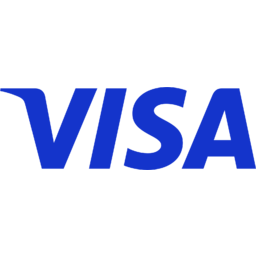
Visa Inc. is a stock corporation and, alongside Mastercard, one of the two major payment card companies and employed around 14,200 people in 2016. The VISA brand is a recursive acronym and stands for Visa International Service Association.
P/E ratio for Visa (V)
P/E ratio as of April 2024 (TTM): 33.1
According to Visa's latest financial reports and stock price the company's current price-to-earnings ratio (TTM) is 33.0602. At the end of 2022 the company had a P/E ratio of 29.1.
P/E ratio history for Visa from 2008 to 2023
PE ratio at the end of each year
| Year | P/E ratio | Change |
|---|---|---|
| 2022 | 29.1 | -18.88% |
| 2021 | 35.8 | -20.58% |
| 2020 | 45.1 | 31.53% |
| 2019 | 34.3 | 21.1% |
| 2018 | 28.3 | -24.76% |
| 2017 | 37.6 | 22.03% |
| 2016 | 30.8 | 8.96% |
| 2015 | 28.3 | -3.61% |
| 2014 | 29.4 | 4.03% |
| 2013 | 28.2 | -40.72% |
| 2012 | 47.6 | 146.19% |
| 2011 | 19.3 | 16.23% |
| 2010 | 16.6 | -35.32% |
| 2009 | 25.7 | -43.11% |
| 2008 | 45.2 |
P/E ratio for similar companies or competitors
| Company | P/E ratio | P/E ratio differencediff. | Country |
|---|---|---|---|
 Mastercard MA | 40.1 | 21.27% | 🇺🇸 USA |
 PayPal PYPL | 19.1 | -42.34% | 🇺🇸 USA |
 Western Union WU | 6.77 | -79.53% | 🇺🇸 USA |
How to read a P/E ratio?
The Price/Earnings ratio measures the relationship between a company's stock price and its earnings per share. A low but positive P/E ratio stands for a company that is generating high earnings compared to its current valuation and might be undervalued. A company with a high negative (near 0) P/E ratio stands for a company that is generating heavy losses compared to its current valuation.
Companies with a P/E ratio over 30 or a negative one are generaly seen as "growth stocks" meaning that investors typically expect the company to grow or to become profitable in the future.
Companies with a positive P/E ratio bellow 10 are generally seen as "value stocks" meaning that the company is already very profitable and unlikely to strong growth in the future.